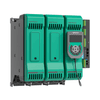GPC power controller for preheating furnaces for aluminium extrusion dies
Find out how to control electric heaters in preheating furnaces with dies for aluminium extrusion
GPC power controller in two-phase mode
The GPC power controller in two-phase mode control the three-phase electric heating coils to obtain diagnostics of:
- partial failure of the heating resistors;
- failure of the protection fuse;
- fielbus connection.
In this way it is possible to carry out preventive maintenance to avoid possible damage up to fire or partial interruption with consequent collapse of the heating system.
Overview
- Application: Control of 3 phase resistors in a Preheating furnace for aluminium extrusion dies
- Products: GPC Power controller to drive resistive heaters connected in 3 Phase mode, providing heater break, blown fuse diagnostic and field bus connectivity.
The process
Aluminum extrusion is an industrial process in which a cylindrical block of aluminum called a billet is compressed through matrix to obtain bars with a constant section.
To allow its compression, before the extrusion process, the billets are heated to a temperature between 450/500 ° C (842/932 ° F).
The billets are then cut by a special machine to the required size and pressed against a perforated steel matrix, heated to the same temperature between 450/500 ° C (842/932 °F) as the billets.
Extruded aluminum products are used in various industrial applications such as Naval, Oil & Gas, Construction.
In the Automotive and Aerospace sector there is an extensive use of aluminum components due to its characteristics of mechanical strength and lightness.
The challenge
Uniform and accurate preheating of extrusion matrix
It is important to use the die at a temperature of 450/500 ° C (842/932 °F) or as close as possible to the temperature of the billet and with minimal temperature variations inside to avoid problems such as:
- An increase in waste at the start of production due to incorrect metal flow.
- Production losses caused by gluing billets.
- Premature damage to the matrices themselves
- Increased oxidation of the internal surface of the matrix reducing the quality of the final product.
The preheating ovens are generally divided into several independent chambers to ensure continuous coverage of the various production changes.
The different heating zones, with electric heaters, are managed by Power Controllers controlled by the PLC.
Product benefits
GPC 3Phase Power controller
- Range: from 40A to 600A single phase / two phase / three phases
- Easy product configuration with the GF_eXpress configurator
- Portable display for local data access and simple configuration by selecting the previous recipe.
- Command mode: configurable
- Heater break alarm with self-learning and full product diagnostic
- Connectivity: all the most commonly used Ethernet field buses
- SCCR UL 508 100KA compliant
Solution
Advanced Power control
GPC Power controller in two-phase mode to control the three legs electric heating batteries.
Two-phase control for three legs heater loads (Figure 2) offers cost advantages over 3-phase control, with the same process control performances. It also reduces space and cooling requirements in the electrical cabinet.
Preventive maintenance
The sparks on power terminals due to improper tightening could be a cause for potential fire which can be avoided by the continuous monitoring of the temperature, provided by the 12 thermistors integrated in the terminals combined with a specific on HOLD automatic procedure.
Partial or total heater break of one leg can be the cause of reduced transfer of energy to the process. A specific diagnostic (Figure 3) and a compensation algorithm between the phases available with the GPC Power Controller enables the power controller to transfer the required energy despite the failure.
Control system integration
The firing of the power controllers can be performed through a PLC system. The Ethernet communication protocols (ProfiNET, Profibus, Ethercat, Ethernet/IP, Modbus TCP / RTU, CANopen) on the GPC Power Controllers enables it to be integrated with plant network and becoming part of the central control system for a seamless operation.




